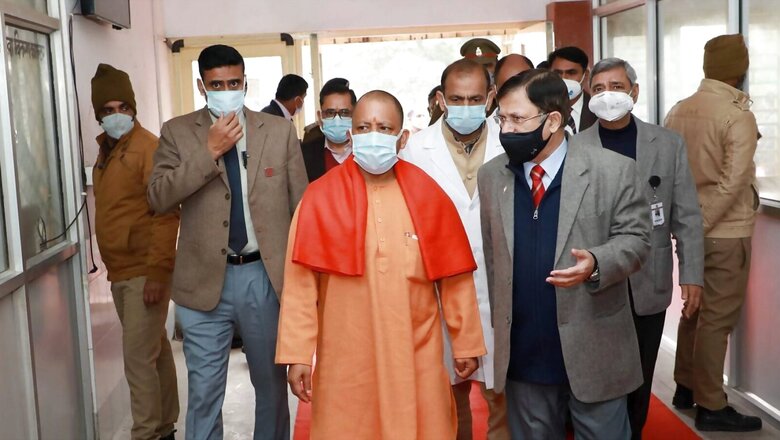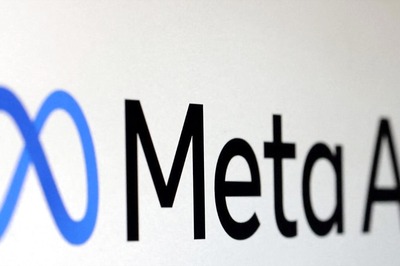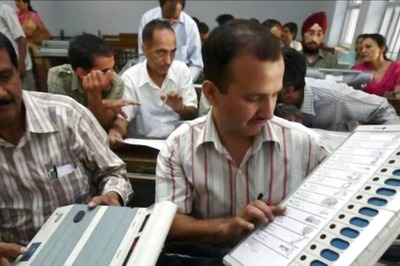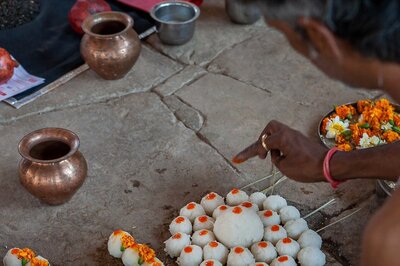
views
Uttar Pradesh Assembly election is underway, where a total of 403 seats are up for contest in seven phases, from February 10 to March 7, 2022. It is once again time for people to assess their political representatives on how they have performed, what they promise next, and who they really are. In what can be called a timely book release, Shantanu Gupta has filled this knowledge gap by writing, once again, about the ‘monk’ who led the people of UP as the chief minister these last five years, with a majority mandate, wherein the Bharatiya Janata Party (BJP) won 312 of 403 seats in the 2017 state election.
Broadly speaking, the book validates the transformation of Uttar Pradesh with credible statistical data and information. Shantanu makes it clear that Yogi Adityanath indeed comes from a humble background, has had a stellar early political career, and his role as chief minister of UP has been nothing short of historical. Particularly, in the way he has tackled the menace of crime through effective policing and law-making. CM Yogi has attracted national and foreign capital investment to UP by providing improvements in infrastructure, which in turn has created lakhs of job opportunities across sectors. It is amazing to read about the progress UP has witnessed in just the last five years. Moreover, reading about the contrast between CM Yogi and his predecessors was an eye-opener.
The title of the book may mislead someone into believing that the book talks mainly about the ‘monk’. However, it would be inappropriate to consider this book CM Yogi Adityanath’s political biography. It rather focuses on the policies and outcomes of his tenure, i.e. the transformation of UP. CM Yogi’s actions as opposed to his words, is what Shantanu highlights.
In the book The Monk who Transformed Uttar Pradesh, Shantanu begins by detailing CM Yogi’s honesty and ostensive commitment to good governance. It was interesting to know that the first thing CM Yogi did was not buy a luxury car, unlike Mayawati (Rs 1 crore for a Land Cruiser) and Akhilesh (Rs 6.9 crore for two Mercedes Benz cars). He rather requested a small change to the older ones — saffron-coloured seat covers, which for him denote ‘renunciation,’ representing ‘his idea of politics — to be indifferent to material gains and completely dedicate himself to his work’.
It was heartening to read that one of the first things CM Yogi did was ban chewing gutka and pan masala in government offices across UP (after seeing stains in most government offices). He also implemented measures to ensure that government employees were both well-disciplined and punctual. Right after assuming office, Yogi Adityanath’s government also helped identify and list over 1,600 archaic laws (as old as 1850) that needed to be repealed.
Shantanu decodes the steps and measures undertaken by CM Yogi to address the infamous Gunda Raj, which resulted in a fear to commit crime, in a state that was once a safe haven for criminals and corrupt officials. Passing of the Uttar Pradesh Control of Organised Crimes (UPCOC) Bill, aimed at curbing organised crime and terror, took on the land mafia, which included Members of Parliament like Azam Khan (who usurped land for Jauhar University) of the Samajwadi Party. This was a blow to criminal factions operating in UP.
Opinion: In Uttar Pradesh, People Have Developed a Stake in Continuation of Yogi Government
The way Akhilesh Yadav’s government would shield terrorists (in order to appease the Muslim community) and plead courts to let go of criminals is in stark contrast to the zero-tolerance policy against terrorism and crime that CM Yogi Adityanath has instituted.
Here is an excerpt from the book on this aspect of the Akhilesh- and Samajwadi Party-led government:
In its 2012 election manifesto, along with the anti-constitutional religion-based reservation for Muslims, Samajwadi Party promised that Muslim youth jailed on charges of terror acts would be released and given adequate compensation. And once Akhilesh Yadav became the Chief Minister of the state, he remembered all the promises made to his Muslim voters, though he forgot most of his other poll promises. He tried to release some of the most dreaded terrorists from the jails of UP. Fortunately, the courts came down heavily on the Akhilesh Yadav government. The court observed thus:
“Who will decide who is a terrorist and who is not? Let the matter be decided in the court? How can the government decide who is a terrorist? Is the government encouraging terrorism by taking steps to withdraw cases against accused persons? Today you are withdrawing cases…tomorrow you will confer Padma Bhushan on them.”
A Division Bench of Allahabad High Court, comprising Justices RK Agarwal and RSR Maurya, gave this observation while hearing a petition challenging the move of the SP government to let off those Muslim youths who were arrested for their alleged involvement in the Lucknow, Faizabad and Varanasi serial blasts of 2007.
In Chapter 2, ‘Why Criminals Fear Yogi’, Shantanu showcases an appalling contrast in commitment to justice, law and order. The following excerpt comes right after Shantanu describes how Yogi successfully instilled a ‘fear of law’ in criminals by addressing the issue in his very first meeting with the home department. Then came the fruits of the determined effort to curb crime — over 45,000 criminals arrested under the Gangster and National Security Acts.
Many dreaded criminals of UP, who used to influence UP’s politics before 2017, have a different address today. Mukhtar Ansari is in Banda jail, Atique Ahmed is in Sabarmati Central jail, Gujarat, Brijesh Kumar Singh is in Varanasi jail, Bablu Srivastava is in Bareilly jail, Muneer is in Tihar jail, Delhi, Khan Mubarak is in Hardoi jail, Akash Jaat is in Ghaziabad jail, Sanjeev Maheshwari (aka Jeeva) is in Lucknow jail, Anil Dujana is in Gautam Budh Nagar jail and Singhraj Bhati is in Gorakhpur jail, to name a few.
Further down in the book, Shantanu illustrates the kind of massive projects undertaken in UP and also highlights the record speed of project completion. For instance, 641 km of expressways were built in five years by the Yogi government, while the Samajwadi Party and the Bahujan Samaj Party (BSP) governments collectively built 467 km of road expressways in 15 years! The developmental projects cover rural and urban electrification, building of expressways, airports, metro stations to improve accessibility, with a greater aim to attract industries, investments, jobs and prosperity back to UP. Thus ‘UP Waala Bhaiya’ became a badge of honour and not a slur as it was used earlier. This is not a fancy statement, written on the cover of the book, but is actually true, something the book and its data justify.
What was particularly worth reading about was the One District One Product (ODOP) programme — a strategic plan with the aim to increase exports of finished products sourced from UP’s 75 districts. The ODOP programme has increased UP’s export capacity by 35 per cent and has benefitted 3.14 lakh entrepreneurs. Additionally, CM Yogi’s UP Investors’ Summit held in 2018 was yet another milestone worth reading about. The result of this summit was that UP ‘signed 1,045 pacts worth Rs 4.28 lakh crore’.
Later on, in the book, Shantanu highlights the One District One Medical College Mission where the Yogi government has nearly tripled the number of medical colleges envisioned for the state and the execution of which is underway in a phased manner. He also highlights the 21-Step Action Plan of the state government to tackle the coronavirus pandemic and prepare the healthcare system for an effective response.
ALSO READ | UP Next: These Social Engineers are the Brains behind Poll Campaigns in Uttar Pradesh
Shantanu then draws the conclusion that the UP government led by CM Yogi is unequivocally pro-farmer, which is reflected in the data, the policies that have helped set new records, the newer technologies that have enabled greater e-selling of crops, and the delivery on the promise to waiver off crop loans of up to Rs 1 lakh, which has ultimately helped and benefitted tens of lakhs of farmers.
Shantanu ends the book by acknowledging that CM Yogi plays an active role in the cultural propagation, civilisational heritage and renaissance of the native and aboriginal people of Bharat. He further describes the ‘Double-Engine Ki Sarkar’ of BJP as a working model of good governance, and why it is a political gateway for what people of Bharat want and aspire to be on local, national and global frontiers. After all, UP today ranks first in its implementation and execution of nearly 44 central government schemes.
As a political analyst and author, Shantanu is adept at capturing minute and significant details of a larger than life personality of CM Yogi Adityanath — ‘The Monk who became Chief Minister’ (also, a 2017 book by Shantanu, where he describes how exactly Ajay Singh Bisht transformed into the selfless, unstoppable force that Yogi Adityanath is). He has simultaneously collated a huge corpus of information to build a case and present it to the people of the world. His data is mainly drawn from news agencies, dailies and news magazines, and is well-researched. The case he builds illustrates how CM Yogi has injected fresh energy into the senile and debased political environment of Uttar Pradesh.
His latest political commentary, actually and factually, summarises the multi-dimensional transformation that has been reported, but hadn’t been compiled for the people to read and appreciate. So, if you wish to know — How has a massive state like Uttar Pradesh transformed under the pioneering leadership of an honest and devoted CM Yogi Adityanath?; If he really deserves to be re-elected in the 2022 Uttar Pradesh Legislative Assembly Election?; If he should be given the opportunity to lead the people of Bharat? — you would find this book by Shantanu Gupta a useful read.
Shrikanth Iyer is Research Associate at Rashtram School of Public Leadership, Rishihood University. The views expressed in this article are those of the author and do not represent the stand of this publication.
Read all the Latest Opinion News and Breaking News here




















Comments
0 comment